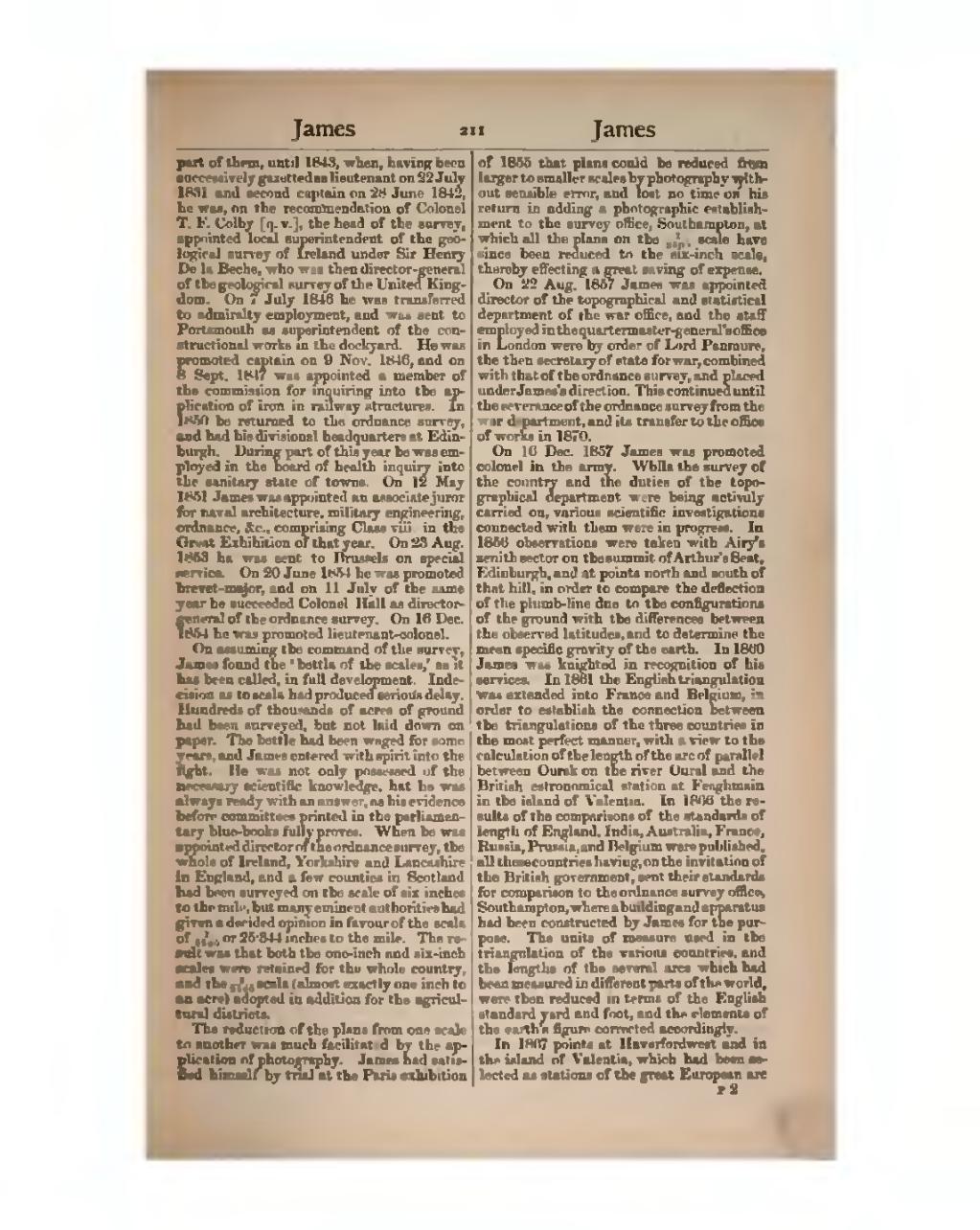part of them, until 1843, when, having been successively gazetted as lieutenant on 22 July 1831 and second captain on 28 June 1842, he was, on the recommendation of Colonel T. F. Colby [q. v.], the head of the survey, appointed local superintendent of the geological survey of Ireland under Sir Henry De la Beche, who was then director-general of the geological survey of the United Kingdom. On 7 July 1846 he was transferred to admiralty employment, and was sent to Portsmouth as superintendent of the constructional works in the dockyard. He was promoted captain on 9 Nov. 1846, and on 8 Sept. 1847 was appointed a member of the commission for inquiring into the application of iron in railway structures. In 1850 he returned to the ordnance survey, and had his divisional headquarters at Edinburgh. During part of this year he was employed in the board of health inquiry into the sanitary state of towns. On 12 May 1851 James was appointed an associate juror for naval architecture, military engineering, ordnance, &c., comprising Class viii. in the Great Exhibition of that year. On 23 Aug. 1853 he was sent to Brussels on special service. On 20 June 1854 he was promoted brevet-major, and on 11 July of the same year he succeeded Colonel Hall as director-general of the ordnance survey. On 16 Dec. 1854 he was promoted lieutenant-colonel.
On assuming the command of the survey, James found the ‘battle of the scales,’ as it has been called, in full development. Indecision as to scale had produced serious delay. Hundreds of thousands of acres of ground had been surveyed, but not laid down on paper. The battle had been waged for some years, and James entered with spirit into the fight. He was not only possessed of the necessary scientific knowledge, but he was always ready with an answer, as his evidence before committees printed in the parliamentary blue-books fully proves. When he was appointed director of the ordnance survey, the whole of Ireland, Yorkshire and Lancashire in England, and a few counties in Scotland had been surveyed on the scale of six inches to the mile, but many eminent authorities had given a decided opinion in favour of the scale of 1/2500 or 25.344 inches to the mile. The result was that both the one-inch and six-inch scales were retained for the whole country, and the 1/2500 scale (almost exactly one inch to an acre) adopted in addition for the agricultural districts.
The reduction of the plans from one scale to another was much facilitated by the application of photography. James had satisfied himself by trial at the Paris exhibition of 1855 that plans could be reduced from larger to smaller scales by photography without sensible error, and lost no time on his return in adding a photographic establishment to the survey office, Southampton, at which all the plans on the 1/2500 scale have since been reduced to the six-inch scale, thereby effecting a great saving of expense.
On 22 Aug. 1857 James was appointed director of the topographical and statistical department of the war office, and the staff employed in the quartermaster-general's office in London were by order of Lord Panmure, the then secretary of state for war, combined with that of the ordnance survey, and placed under James's direction. This continued until the severance of the ordnance survey from the war department, and its transfer to the office of works in 1870.
On 16 Dec. 1857 James was promoted colonel in the army. While the survey of the country and the duties of the topographical department were being actively carried on, various scientific investigations connected with them were in progress. In 1856 observations were taken with Airy's zenith sector on the summit of Arthur's Seat, Edinburgh, and at points north and south of that hill, in order to compare the deflection of the plumb-line due to the configurations of the ground with the differences between the observed latitudes, and to determine the mean specific gravity of the earth. In 1860 James was knighted in recognition of his services. In 1861 the English triangulation was extended into France and Belgium, in order to establish the connection between the triangulations of the three countries in the most perfect manner, with a view to the calculation of the length of the arc of parallel between Oursk on the river Oural and the British astronomical station at Feaghmain in the island of Valentia. In 1866 the results of the comparisons of the standards of length of England, India, Australia, France, Russia, Prussia, and Belgium were published, all these countries having, on the invitation of the British government, sent their standards for comparison to the ordnance survey office, Southampton, where a building and apparatus had been constructed by James for the purpose. The units of measure used in the triangulation of the various countries, and the lengths of the several arcs which had been measured in different parts of the world, were then reduced in terms of the English standard yard and foot, and the elements of the earth's figure corrected accordingly.
In 1867 points at Haverfordwest and in the island of Valentia, which had been selected as stations of the great European arc
